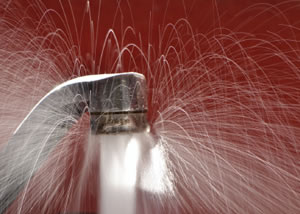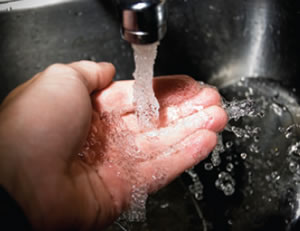Water, Water Everywhere
Water conservation on college campuses moves into high gear.
- By Sherrie Negrea
- 11/01/13

PHOTO COURTESY OF DANIEL PARKS
With an average rainfall of only ten inches per year, California State University San Marcos lies in an arid environment that is considered just over the desert threshold. Though the university has been conscious of saving water since it was built in 1990, its efforts have intensified in the past four years as water rates have skyrocketed in Southern California.
In 2009, the university installed 72 waterless urinals on campus and began replacing older fixtures with low-flow faucets and toilets. It purchased a computerized irrigation system that detects leaks and prevents watering systems from turning on when it does rain. And it has transformed its campus into a drought-tolerant landscape full of native plants that require minimal watering.
All told, the university is saving more than 2,000,000 gallons of water per year, amounting to more than $74,000 in annual reduced costs.
“Water is an essential and limited resource,” says Edward Johnson, the university’s director of Sustainability and Utilities Department. “We need it to survive. The plants need it to survive too. We have to be aware about how we use it.”
Colleges and universities in the driest regions of the country are not the only institutions that are ramping up their water conservation programs. As the sustainability movement has swept across college campuses nationwide, efforts to reduce water consumption have become part of the push to make schools more environmentally friendly, even in states that receive substantial rainfall.
Water Fixtures
Up until five years ago, all the toilets, showers and sinks at Kenyon College in Gambier, OH, were high-flow devices that were wasting millions of gallons of water. But this past summer, the college completed a project that upgraded more than 1,300 water fixtures in its residence halls, academic buildings and dining halls.
The college installed 1.6-gallon-perflush toilets throughout campus, replacing three-gallon-per-flush fixtures. In addition, it purchased new showers that use half a gallon of water per minute, substantially less than older models that were releasing two or three gallons per minute.
Altogether, the upgrades are saving $127,000 in water and sewage costs annually. “Doing it all at once made a pretty big impact,” says Everett Neal, the college’s sustainability director.
Another major user of water were the dining hall sinks. Because of a requirement that food service employees sanitize their hands every time they turned on a faucet, the water was often left on during food preparation. To eliminate this problem, the college added foot valves to the sinks, which allowed food service employees to turn the water on and off without having to touch the faucets.
“The cooks would leave the faucets on because there was a concern of crosscontamination,” says Neal. “If they touched the faucet, then they would have to turn it off and wash their hands. In a lot of cases, they would just leave the water on for hours, and that adds up.”
Trayless Dining
In campus dining halls, washing a food tray can use up to half a gallon of water. Boston University, where 2,000 trays were being washed on campus 35 times a week, decided to switch to trayless dining in 2008 to save water, reduce the use of detergents and drying agents, and cut food waste.
At first, a vocal minority of students complained about not being able to pile their food onto plastic trays, but after a few weeks, the grumbling stopped. Since the trays were eliminated, the university estimates it is saving 35,000 gallons of water each week.
“It’s part of the culture now,” says Dennis Carlberg, the university’s sustainability director. “People don’t even think about needing a tray.”
Installing more efficient dishwashers has also conserved water in the university’s dining halls. The new dishwashers use a conveyer belt system that reuses “gray” water from the cleaning process to convey food waste to a centrifugal machine; the equipment then extracts the water from the scraps, which are transported to a nearby farm for composting.
“It saves a lot of water,” Carlberg says. “It saves a lot of energy, and it helps reduce our carbon footprint.”
In the Kitchen
Campus food service facilities are becoming a focal point for water conservation efforts. Manufacturers of restaurant equipment and fittings have responded with research, development and production of new and very efficient products.
Commercial pre-rinse spray valves (PRSVs) are part of the prerinse operation in the dish room of a typical food service operation. They are used to remove the large particles of food from dishware and utensils prior to loading them in the dishwasher.
Many facilities use two or three PRSVs. According to the Alliance for Water Efficiency, a conservative estimate of (hot water) pre-rinse spray valves installed in dish rooms in North America is 1,000,000 units.
Most standard-flow spray valves flow at 3.0 gallons per minute (gpm) or more of hot water. The flow rate of water and energy-efficient models is only 1.6-gpm or less. The efficient models are equally effective in cleaning the dishes as the non-efficient units.
Commercial dishwashers and PRSVs together represent the largest consumer of water in food service operations. In the late 1990s, NSF International (the listing agency for such machines) showed that the most efficient dishwashers used 1.2 gallons of water per (20-inch by 20-inch) rack. Today, machines are available at well below one gallon per rack.
Connectionless/boilerless food steamers. A field study by the Food Service Technology Center (www.fishnick.com) confirmed that the relatively new connectionless technology yields significant water use reductions in food service (more than 80 percent), due largely to the elimination of condensate-cooling water.
The water and energy efficiency of commercial ice makers both vary significantly among the many equipment models on the market. In general, however, air-cooled machines are more water-efficient, energy-efficient and cost-effective.
Source: The Alliance for Water Efficiency (www.allianceforwaterefficiency.org).
Lake-Source Cooling
Chilling water to operate air conditioning systems uses massive volumes of water on a college campus. Cornell University decided to tackle this problem by building a $58.5-million lake-source cooling complex that draws frigid water from nearby Cayuga Lake and uses it to chill water that is piped to the central campus.
The system takes 39°F water from a deep region of the Finger Lakes in Ithaca, NY, and pumps it into a heat-exchange facility on the shore. The warmer campus water is chilled, sent to campus, and then recycled back in a closed-loop system.
Without the lake-source cooling complex, built in 2000, the university would need to use conventional chillers that would require 125 million gallons of water annually. The new method for chilling water has also reduced the campus energy use for cooling by 80 percent.
“It is a huge electricity savings in addition to the water conservation,” says Sarah Zemanick, a campus sustainability management specialist at Cornell.

PHOTO COURTESY OF TREVIN SHIREY
PEDAL TO THE METAL. Install pedal-operated foot controllers for faucets. Using pedal-operated foot controls for faucets at the dish station or hand sink will prevent water from running in excess in food service facilities.
Conserving Water in a Drought
Situated in a suburban community that has been under drought conditions for the past three years, The University of Texas at Dallas launched a series of stringent conservation measures that not only saves water but also monitors usage.
One of its most innovative projects is harvesting rainwater in its three-year-old student services building, collecting it in a large cistern and reusing as “gray” water for irrigation and flushing toilets. The harvesting system will be installed in a second building — a new biosciences and bioengineering building that will be constructed next year.
Landscaping was another major consumer of water that the university targeted. Four years ago, the university began transforming its landscaping by removing turf and replacing it with more drought-tolerant plantings.
“We’ve stuck to ornamental grasses as opposed to turf grasses, which require a lot of water,” says Jay Jascott, the university’s landscape supervisor. “And we pulled out of our annual color and converted them to perennial beds.”
A computerized irrigation system was installed to detect leaks and monitor usage. Drip irrigation was also added to replace less efficient sprinklers, which alone resulted in a 10 percent reduction in water usage.
The university has launched other water conservation measures on its 445-acre campus, including the installation of dual-flush toilets, automatic sensors in faucets and more efficient cooling towers.
“Our community is saving water, and it’s important for us too,” says Thea Junt, the university’s assistant director of energy conservation and sustainability. “We’ve been doing everything possible to save water.”
This article originally appeared in the College Planning & Management November 2013 issue of Spaces4Learning.